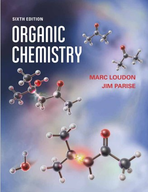Solution Found!
Give the principal product(s) expected, if any, when trans-1,3-pentadiene reacts under
Chapter 15, Problem 15.43(choose chapter or problem)
Give the principal product(s) expected, if any, when trans-1,3-pentadiene reacts under the following conditions. Assume one equivalent of each reagent reacts unless noted otherwise.
(a) \(\mathrm{Br}_{2} \text { (dark) in } \mathrm{CH}_{2} \mathrm{Cl}_{2}\)
(b) HBr
(c) \(\mathrm{H}_{2}\) (two molar equivalents), Pd/C
(d) \(\mathrm{H}_{2} \mathrm{O}, \mathrm{H}_{3} \mathrm{O}^{+}\)
(e) \(\mathrm{Na}^{+} \mathrm{EtO}^{-} \text {in } \mathrm{EtOH}\)
(f) maleic anhydride (see Eq. 15.13a, p. 739), heat
Questions & Answers
QUESTION:
Give the principal product(s) expected, if any, when trans-1,3-pentadiene reacts under the following conditions. Assume one equivalent of each reagent reacts unless noted otherwise.
(a) \(\mathrm{Br}_{2} \text { (dark) in } \mathrm{CH}_{2} \mathrm{Cl}_{2}\)
(b) HBr
(c) \(\mathrm{H}_{2}\) (two molar equivalents), Pd/C
(d) \(\mathrm{H}_{2} \mathrm{O}, \mathrm{H}_{3} \mathrm{O}^{+}\)
(e) \(\mathrm{Na}^{+} \mathrm{EtO}^{-} \text {in } \mathrm{EtOH}\)
(f) maleic anhydride (see Eq. 15.13a, p. 739), heat
ANSWER:Step 1 of 6
(a)
Reaction with \(\mathrm{Br}_{2}\) (dark) in \(\mathrm{CH}_{2} \mathrm{Cl}_{2}\):
Electrophilic addition is initiated by reaction of a terminal carbon of one of the double bonds with Br2 to give an allylic carbocation intermediate. Reaction of bromide at one of the carbons bearing partial positive charge gives the 1,2-addition product ; reaction at the other gives the 1,4-addition product.
The allylic carbocation intermediate can be represented as a resonance hybrid of two contributing structures. Conjugation which results in resonance stabilization and the formation of this very stable cation is the rate determining step.
At room temperature, 1,4-addition takes place to give 1,4-dibromopent-2-ene via allylic carbocation intermediate. This intermediate on addition of bromide ion gives the stable disubstituted alkene (on rearrangement). If the temperature is below zero, rearrangement won’t occur and the product will be 1,2-dibromopent-3-ene.
